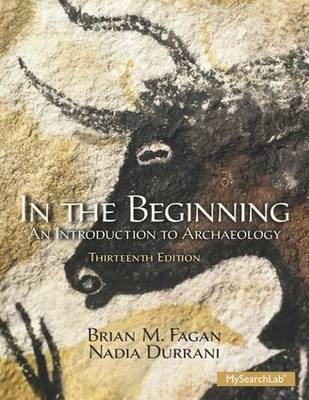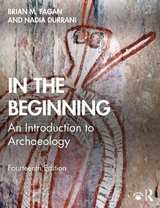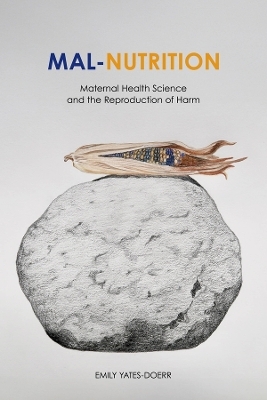
In the Beginning
Pearson (Verlag)
978-0-205-96658-5 (ISBN)
- Titel erscheint in neuer Auflage
- Artikel merken
In the Beginning: An Introduction to Archaeology presents the history and methods of archaeology and explores its significance today. The text introduces archeology’s basic principles along with numerous examples from all over the world. Authors Brian Fagan and Nadia Durrani provide a comprehensive summary of the field for people who have little or no experience.
MySearchLab is a part of the Fagan/Durrani program. Research and writing tools, including access to academic journals, help students explore archaeology in even greater depth. To provide students with flexibility, students can download the eText to a tablet using the free Pearson eText app.
0205968031 / 9780205968039 In the Beginning: An Introduction to Archaeology Plus MySearchLab with eText -- Access Card Package
Package consists of:
0205239927 / 9780205239924 MySearchLab with Pearson eText -- Valuepack Access Card
0205966586 / 9780205966585 In the Beginning: An Introduction to Archaeology
Brian Fagan is one of the world’s leading archaeological writers and an internationally recognized authority on human prehistory. He studied archaeology and anthropology at Pembroke College, Cambridge University, and then spent seven years in sub-Saharan Africa working in museums and in monuments conservation and excavating early farming sites in Zambia and East Africa. He was one of the pioneers of multidisciplinary African history in the 1960s. From 1967 to 2003, he was professor of anthropology at the University of California, Santa Barbara, where he specialized in lecturing and writing about archaeology to wide audiences. He is now Emeritus Professor of Anthropology. Brian Fagan has written several best-selling textbooks and has published several scholarly monographs on African archaeology and numerous specialized articles in national and international journals. An expert on multimedia teaching, he has received the Society for American Archaeology’s first Public Education Award for his tireless efforts on behalf of archaeology and education Brian Fagan’s other interests include bicycling, sailing, kayaking, and good food. He is married and lives in Santa Barbara with his wife and daughter, three cats (who supervise his writing), and last but not least, a minimum of seven rabbits. Nadia Durrani is an archaeologist and writer. For much of the past decade she was the editor of Britain’s best-selling archaeology magazine, Current World Archaeology, becoming an independent editor after the arrival of her son in 2010. She has authored and edited many hundreds of articles on archaeology from every corner of the globe, contributed to dozens of books, and written two. Throughout her career she has travelled widely --from Peru to Pakistan--to report on the latest archaeological discoveries; worked as a specialist lecturer on archaeological tours to countries including Yemen and Jordan; and contributed to a range of television documentaries. Her specialist area is Arabian archaeology and, following a degree in archaeology and anthropology from Cambridge University, she took a PhD in South West Arabian archaeology from University College, London (2001). Other research interests include the archaeology of the First World War and she is a founding member of the Great War Archaeology Group. A fellow of the Society of Antiquaries, she lives in London with her husband, Matthew, and son Jacob ‘Caractacus’ Hillier.
In this section:
1. Brief Table of Content
2. Full Table of Contents
BRIEF TABLE OF CONTENTS
PART I: Background to Archaeology
Chapter 1: Introducing Archaeology
Chapter 2: The Beginnings of Scientific Archaeology: Sixth Century B.C. to the 1950s
Chapter 3: The Many-Voiced Past: Archaeological Thought from the 1950s to Now
PART II: The Basics
Chapter 4: Matrix and Preservation
Chapter 5: Doing Archaeological Research
Chapter 6: Culture, Data, and Context
Chapter 7: How Old Is It?
PART III: Recovering the Data
Chapter 8: They Sought It Here, They Sought It There: Finding the Past
Chapter 9: How to Excavate
PART IV: Analyzing the Past: Artifacts and Technology
Chapter 10: Classifying Artifacts
Chapter 11: Technologies of the Ancients
PART V: Studying Environments and People
Chapter 12: Ancient Environments
Chapter 13: What Did We Eat?
Chapter 14: The Living Past
Chapter 15: Landscape and Settlement
Chapter 16: Interactions: People of the Past
Chapter 17: Archaeology and the Intangible
PART VI: Managing the Past
Chapter 18: Cultural Resource Management and Public Archaeology
Chapter 19: Archaeology and Contemporary Society
PART VII: Careers and Resources
Chapter 20: So You Want to Become an Archaeologist?
FULL TABLE OF CONTENTS
PART I: Background to Archaeology
Chapter 1: Introducing Archaeology
The First Archaeologist
What is Archaeology Today?
Who are the Archaeologists?
Why Study Archaeology?
Who Owns the Past?
Is Archaeology in Crisis?
What are the Goals of Archaeology?
Chapter 2: The Beginnings of Scientific Archaeology: Sixth Century B.C. to the 1950s
Beginnings
Scriptures and Fossils
The Antiquity of Humankind
The Three-Age System
Human Progress
Historical Particularism
Culture History
Old World Archaeology
American Archaeology
The Americas: Chronology and Time Scales
Cultural Ecology
Chapter 3: The Many-Voiced Past: Archaeological Thought from the 1950s to Now
Culture History
The “New” Archaeology
Processual Archaeology
Postprocessual Archaeology
Some Schools of Archaeological Theory
Where is Archaeological Theory Headed?
PART II: The Basics
Chapter 4: Matrix and Preservation
Archaeological Data
Site-Formation Processes
Discovery: Eruption at Akrotiri, Greece, c. 1688 B.C.
The Matrix: Preservation and Human Activity
Preservation Conditions: Inorganic and Organic Materials
Organic Materials and the Archaeological Record
Chapter 5: Doing Archaeological Research
The Archaeologist’s Skills
Archaeology and Science
The Process of Archaeological Research
Chapter 6: Culture, Data, and Context
The Concept of Culture
The Nature of Culture
Models of Culture
The Archaeological Record
Matrix and Provenance
Archaeological Context
Artifacts, Subassemblages, and Assemblages
Archaeological Sites
Cultures, Areas, Regions, and Settlement Patterns
Chapter 7: How Old Is It?
Cyclical and Linear Time
Relative Chronology
Absolute Chronology
PART III: Recovering the Data
Chapter 8: They Sought It Here, They Sought It There: Finding the Past
Finding Archaeological Sites
Approaches to Archaeological Survey
Remote Sensing
Recording Archaeological Sites
Subsurface Detection
Chapter 9: How to Excavate
Directors, Teams, and Staffs
Permits
Planning an Excavation
Tools of the Trade
The Process of Archaeological Excavation
Special Excavation Issues
PART IV: Analyzing the Past: Artifacts and Technology
Chapter 10: Classifying Artifacts
Classification
Processes of Archaeological Classification
Assemblages and Patterns
What Do Assemblages and Patterns Mean?
Chapter 11: Technologies of the Ancients
Stone
Clay (Ceramics)
Metals and Metallurgy
Bone
Wood
Basketry and Textiles
PART V: Studying Environments and People
Chapter 12: Ancient Environments
Long-Term and Short-Term Climatic Change
Geoarchaeology
Long-Term Climatic Change: The Great Ice Age
Holocene Environmental Reconstruction
Reconstructing Humanly-Caused Environmental Change
Chapter 13: What Did We Eat?
Studying Subsistence
nimal Bones (Zooarchaeology)
Plant Remains
Birds, Fish, and Mollusks
Subsistence Data from Rock Art
Ancient Diet
Chapter 14: The Living Past
Early Comparisons
Analogy
Middle-Range Theory
Ethnoarchaeology
Experimental Archaeology
Chapter 15: Landscape and Settlement
Settlement Archaeology and Settlement Patterns
Households
Communities
Studying Large Communities
Studying Distributions of Communities
Case Studies of Settlement Distribution
The Archaeology of Landscape
Chapter 16: Interactions: People of the Past
An Individual: Ötzi the Ice Man
Bioarchaeology: What Human Bones Tell Us
Genetics and DNA
Groups: Ancient Social Organization
Gender: (Beyond) Men and Women
Engendered Research
Ethnicity and Inequality
Exchange and Trade
Chapter 17: Archaeology and the Intangible
A Framework of Common Belief
Cognitive Archaeology
Ethnographic Analogy and Rock Art
The Archaeology of Death
Artifacts: The Importance of Context
Artifacts and Art Styles
Sacred Places
Astroarchaeology and Stonehenge
Southwestern Astronomy and Chaco Canyon
PART VI: Managing the Past
Chapter 18: Cultural Resource Management and Public Archaeology
Legislating the Past
What Is Protected?
Phases of Site Management
Management versus Research
Strategies of CRM Research
Management Challenges
Public Involvement and Public Archaeology
Native Americans and CRM
Cultural Resource Management around the World
Chapter 19: Archaeology and Contemporary Society
Archaeology and Human Diversity
Archaeology and Human History
Archaeological Tourism
Archaeology and Subsistence Agriculture
Garbology
Archaeology and the Environment
Heritage and Stewardship
PART VII: Careers and Resources
Chapter 20: So You Want to Become an Archaeologist?
Archaeology as a Profession
Academic Qualifications: Graduate School
Thoughts on Not Becoming a Professional Archaeologist
Our Responsibilities to the Past
| Erscheint lt. Verlag | 18.10.2013 |
|---|---|
| Sprache | englisch |
| Maße | 216 x 276 mm |
| Gewicht | 866 g |
| Themenwelt | Geisteswissenschaften ► Archäologie |
| Sozialwissenschaften ► Soziologie | |
| ISBN-10 | 0-205-96658-6 / 0205966586 |
| ISBN-13 | 978-0-205-96658-5 / 9780205966585 |
| Zustand | Neuware |
| Informationen gemäß Produktsicherheitsverordnung (GPSR) | |
| Haben Sie eine Frage zum Produkt? |
aus dem Bereich



